With Pride Month well underway, it’s a timely moment to reflect on the state of DEI in finance. Luckily, the findings from PublicRelay’s Q1 2025 Finance Benchmark Report offer a revealing snapshot marked by both progress and pullback.
The Disconnect Between Policy and Perception
Despite strong earnings and innovation-driven headlines, many financial institutions found themselves under the media microscope for scaling back their commitments to diversity, equity, and inclusion. The report highlights that diversity and inclusion in finance remains a reputational flashpoint, with DEI rollbacks drawing significant scrutiny.
Interestingly, this scrutiny didn’t always translate into internal backlash. In many cases, workplace sentiment remained neutral or even positive, suggesting a disconnect between how DEI decisions are perceived externally versus how they are experienced internally. This gap presents an opportunity for financial institutions to better align their messaging with their values.
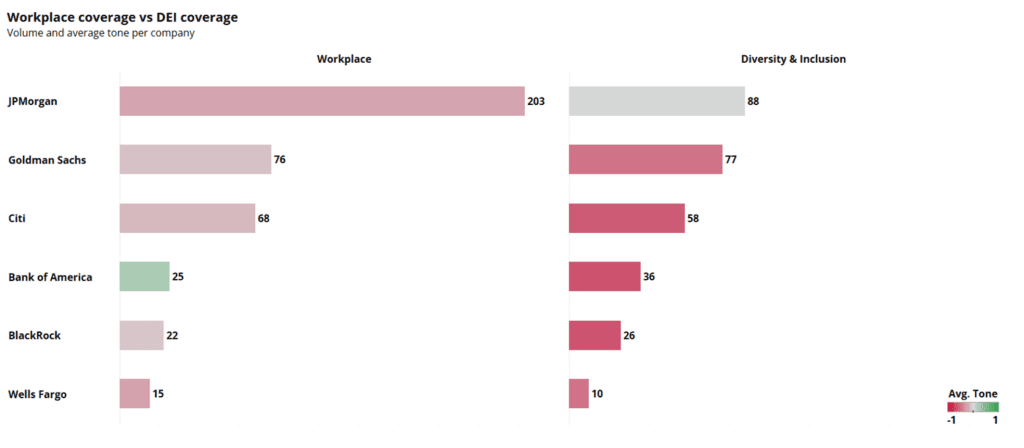
Symbolism vs. Substance in DEI Commitments
One of the most revealing takeaways from the report is how surface-level changes, such as editing DEI language or quietly removing inclusive content, are being interpreted. Rather than being seen as strategic repositioning, these actions are often viewed as capitulating to political pressure. In the eyes of the media and stakeholders, this signals a retreat from core values.
For companies looking to lead during Pride Month, this is a critical lesson. Pride Month corporate responsibility isn’t about rainbow logos or one-time donations. It’s about demonstrating a sustained, authentic commitment to equity and inclusion. Symbolic gestures, while visible, are no substitute for meaningful action.
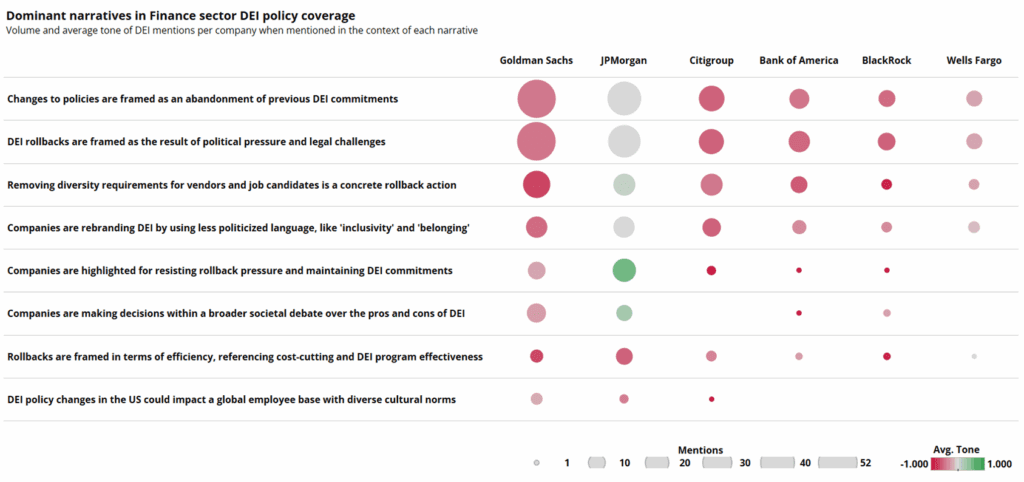
Leadership Matters: The Case of JPMorgan
Leadership plays a pivotal role in shaping the narrative around DEI in finance. Jamie Dimon, CEO of JPMorgan, offers a compelling example. While the bank did implement significant DEI policy changes, Dimon’s vocal support for diverse communities helped mitigate negative sentiment. His public stance was framed as a refusal to cave to political and legal pressures, reinforcing the importance of executive visibility in maintaining trust.
This underscores a broader truth: in times of reputational risk, leaders who speak clearly and consistently about their values can help steer the conversation in a more positive direction.
The Path Forward: From Compliance to Culture
During Pride Month and beyond, financial institutions have an opportunity to reaffirm and act on past commitment to diversity and inclusion. According to the data, this is the most likely route to avoiding negative coverage in the media and with stakeholders. Companies that remain transparent and consistent in their DEI efforts are more likely to earn the trust of employees, customers, and investors alike, bolstering their reputations in the process. In sum, values-driven leadership is good ethics and good business.
Communications teams rely on precise data to navigate complex stakeholder sentiment. For decades, polling has been a cornerstone of this effort, providing valuable, quantifiable benchmarks of opinion. However, in today’s 24/7 information cycle, relying exclusively on this static and inconsistent methodology to understand how stakeholders view your brand is insufficient.
From a data science perspective, polling presents two core challenges: data latency and potential sampling bias. The insights are inherently retrospective—a snapshot of a moment in time. By the time the data is collected and analyzed, the narrative ground may have already shifted. This is compounded by the high cost of frequent polling and the inherent difficulty in surveying specific, influential stakeholders like policymakers who are often media-driven but survey-averse.
While valuable, surveys should not be your only sentiment collection method. The path to a more robust strategy lies in augmenting polling data with more timely media intelligence.
By applying sophisticated modeling to a daily firehose of traditional and social media, we transform millions of unstructured data points into a structured, continuous signal of stakeholder sentiment. This model is not a replacement for polling, but a vital complement that fills the critical gaps between your surveys.
This dynamic signal helps capture emerging narratives and subtle shifts in public perception—often before they show up in polling data. That’s especially critical in the context of issues or crisis management, where early detection of minor negative turns in sentiment can provide a crucial window to act. Without this visibility, by the time a poll reflects trouble, the situation may already be escalating.
When it comes to media intelligence vs polling, the smartest approach is not choosing one over the other, but combining them. When integrated, these two datasets provide a more complete, contextualized understanding. The poll offers the “what”—a structured measure of opinion. The media data provides the “why”—the daily narrative drivers and sentiment shifts influencing that opinion.
Most importantly, this media signal functions as a leading indicator for your survey data. PublicRelay analysis consistently shows that sustained shifts in media sentiment and narrative are predictive of future polling outcomes. This foresight offers a significant strategic advantage:
- Anticipate Outcomes: By tracking the daily media signal, you can forecast the likely results of your next survey, allowing your team to prepare and manage expectations.
- Enable Proactive Intervention: More powerfully, this early warning allows you to move from a reactive to a proactive posture. Identifying an emerging negative narrative in the media data gives you a crucial window to intervene, launching a targeted communications strategy to reshape the conversation before that sentiment solidifies and is reflected in your polling.
Fusing these two data streams—media intelligence vs polling—provides a more resilient, predictive, and strategically sound foundation for modern communications. It allows you to understand, anticipate, and ultimately shape stakeholder perspectives with greater precision and confidence.
Diversity, Equity, and Inclusion (DEI) remain critical pillars for corporate reputation, especially in industries as public-facing as the restaurant sector. PublicRelay’s Q1 Benchmark 2025 dataset, which analyzed media from 50 companies across nine sectors, shines a spotlight on how DEI initiatives (or the rollback of these initiatives) impact corporate reputation through the eyes of key stakeholders. Using a stakeholder-centric methodology, PublicRelay examined media sentiment across seven key personas: Customers, Shareholders, Employees, Business Partners, Regulators, Left-Leaning Policymakers, and Right-Leaning Policymakers.
Methodology: Understanding Stakeholder Perceptions
Using PublicRelay’s AI-enabled model, our Insights & Analytics team analyzed high-relevance articles published in the Top 50 English-language outlets, assigning sentiment scores ranging from -2 (very negative) to +2 (very positive). Unlike traditional sentiment analysis, which aggregates public opinion broadly, this model assesses sentiment specifically from each stakeholder perspective, allowing for nuanced insights into how different groups react to DEI narratives.
This multi-dimensional analysis provides companies with a granular understanding of reputation risks and opportunities tied to DEI. For example, while policy rollbacks might receive tepid reactions from shareholders, they can trigger sharp negativity among employees or left-leaning policymakers. This divergence underscores the importance of targeted messaging that considers stakeholder-specific concerns.
Key Findings: Stakeholder Reactions to DEI in the Restaurant Sector
1. Starbucks and McDonald’s: Leaders in DEI Narratives
Despite media coverage of policy changes, Starbucks and McDonald’s maintained some of the most positive DEI sentiment. Starbucks’ rollback of its open-door policy generated surprisingly limited backlash, largely due to messaging around employee safety concerns, transparency around the new guidelines, and reiterating that this policy has long been common among retailers. In contrast, McDonald’s policy adjustments concerning staff and suppliers were met with sharper criticism, particularly from employee-focused narratives. The company tempered this by referencing its progress on prior DEI goals and commitment to inclusion in a widely released note.
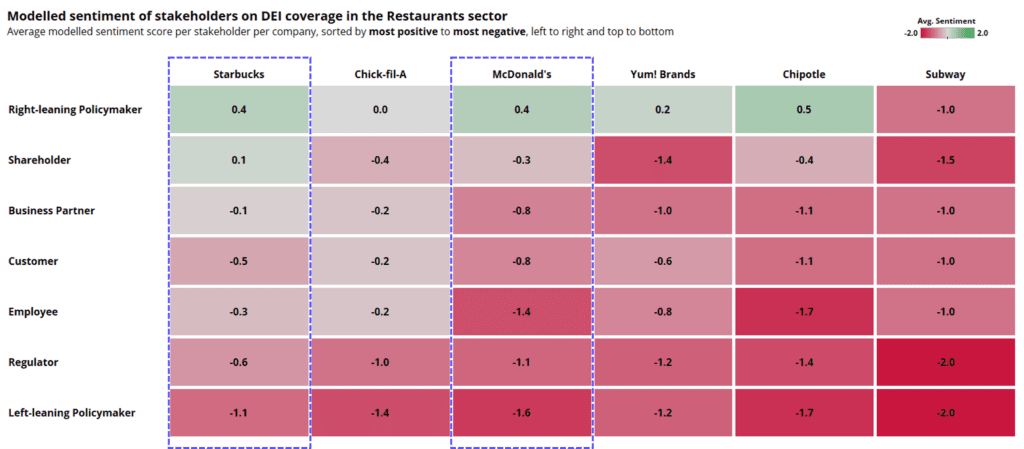
2. Silent Players: Flying Under the Radar
Brands like Yum! Brands and Chipotle managed to avoid significant negative coverage despite DEI-related controversies. For example, Yum! Brands appeared on a Trump administration “hit list,” yet received minimal individual media attention. Chipotle removed DEI language from its annual report, but its refusal to comment effectively stunted media momentum.
3. Political Influence on DEI Perception
One of the more surprising findings was the consistency of negative sentiment around discrimination allegations even among right-leaning policymakers. This indicates that DEI missteps transcend political alignment, reinforcing that discrimination narratives are broadly reputationally damaging.
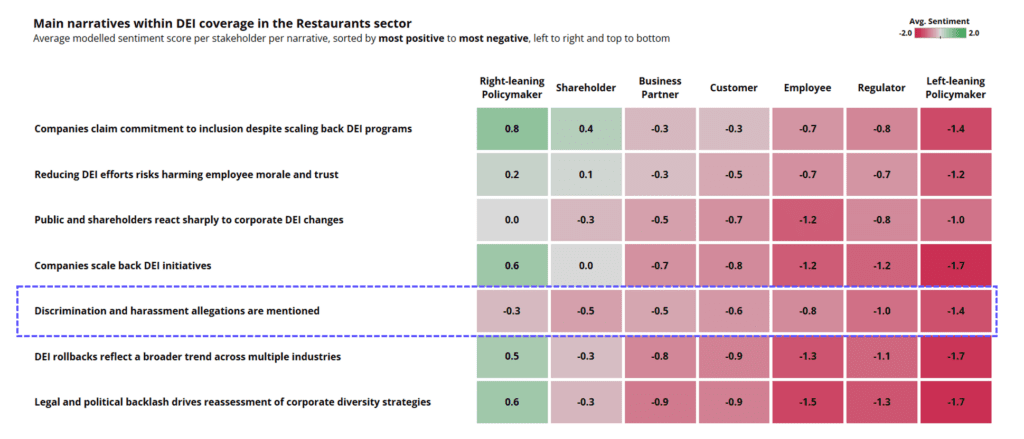
4. The Impact of Positive DEI Messaging
Mentions of company commitments to inclusion can moderate reactions to reported DEI rollbacks across nearly all stakeholder groups.

Shifting Narratives: How DEI Messaging Can Mitigate Reputational Risk
The data reveals that not all DEI-related coverage is equal. Companies that preemptively communicate their commitment to diversity and equity—especially during policy shifts—are better positioned to temper backlash. For brands navigating DEI changes, aligning messaging with core values and stakeholder expectations is crucial.
Communicate Continuity, Not Just Change
When companies announce DEI rollbacks or adjustments, framing the conversation around ongoing commitments can mitigate negative reactions. As we’ve seen, McDonald’s was able to somewhat cushion backlash by referencing prior DEI achievements and its long-term inclusion goals. This contextualizes the change as part of a broader, evolving strategy rather than an abandonment of principles.
Leverage Leadership Voices
Adding authentic statements from CEOs or other executives can lend credibility to inclusion commitments. Media coverage that included executive-level assertions of company values saw more balanced stakeholder reactions, as it provided a counter-narrative to headlines focused solely on policy changes.
Anticipate Stakeholder Reactions
Understanding the specific concerns of different stakeholders allows companies to craft more resonant messages. Shareholders, for example, leaned more neutral to rollback announcements, contradicting media assumptions that these moves would be positively received. Meanwhile, employees and policymakers were notably more reactive to discrimination-related coverage.
Avoiding the Media Frenzy
Brands like Chipotle demonstrated that strategic silence can sometimes be effective. By declining to comment on DEI language removal, Chipotle prevented the story from gaining traction. While not always a viable strategy, selective engagement with the media can minimize narrative escalation.
Conclusion: Prioritizing Perception
For companies in the restaurant sector, DEI narratives carry significant reputational weight. Proactive communication, stakeholder-centric messaging, and strategic leadership involvement can help mitigate backlash and maintain positive sentiment across key personas. In an era where DEI is both a corporate expectation and a media focal point, mastering the narrative is essential for brand resilience.
Learn more about how PublicRelay’s Benchmark insights can guide your stakeholder strategy. Connect with us.
The Impact of a Consumer Impact Crisis
When a consumer impact crisis hits, the ripple effects can be both immediate and long-lasting. These crises—triggered by product failures, safety concerns, or sudden price hikes—directly affect customers’ experiences and drive a surge in media coverage. In fact, PublicRelay’s Benchmark data shows that consumer impact crises generate 135 times more negative media stories compared to a typical day. High-profile incidents like prolonged service outages or massive product recalls often dominate headlines, amplifying reputational risks.
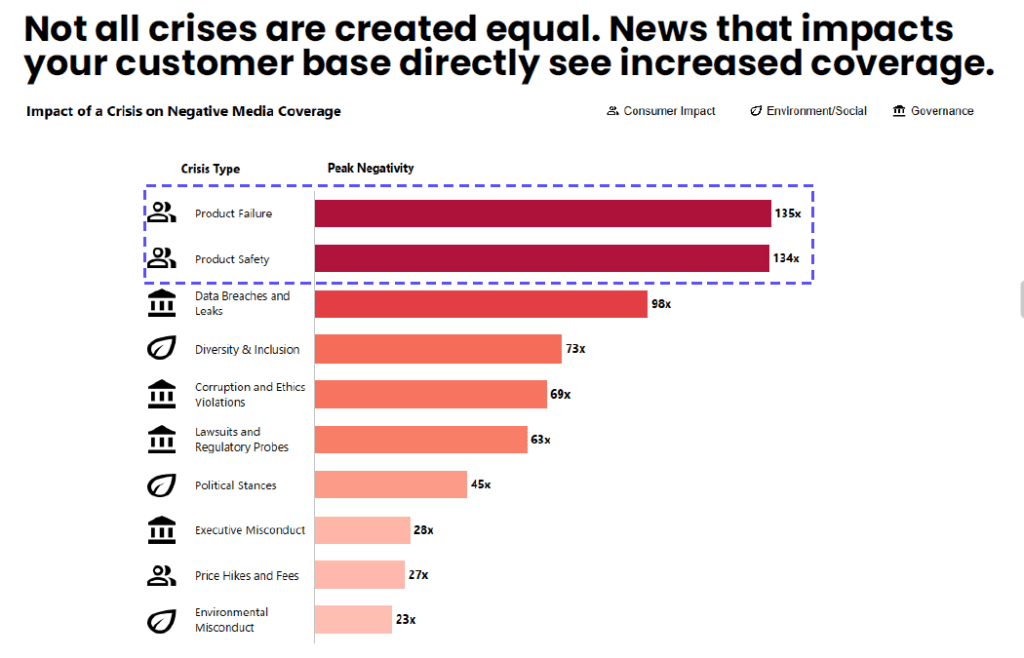
Some examples include:
- The Quaker Oats incident of 2024, where over 60 products were recalled due to salmonella risk, resulting in the shutdown of their Danville, IL manufacturing facility due to ongoing unsanitary conditions.
- Multiple safety issues with Boeing planes that led to a hearing in front of the Senate Commerce Committee and fears of boarding a Boeing-built aircraft.
- The deadly Boar’s Head listeria outbreak resulting from unimaginable conditions at their now-closed Virginia facility, which killed 10 people and has recently ended with a $3.1M settlement as part of a class-action lawsuit.
These can be extremely harmful to your company’s reputation, so how do you strategically navigate a consumer impact PR crisis if you find yourself in this situation? It is important to remember that regardless of your response, there’s likely to be some sort of penalty to long-term media reputation.
The following actions can help mitigate that:
1. Take Direct Action Immediately
Consumers are quick to pass judgment on brands that appear slow to act. The first hours of a crisis are critical. Swift, decisive action can make a significant difference in shaping public perception. If products need recalling, act without hesitation. Expand customer support options to handle the surge in inquiries. Taking these steps shows commitment to minimizing negative effects for your customers, which can soften the immediate blow to your brand’s reputation.
2. Emphasize Transparency
Rebuilding trust starts with open communication. Acknowledge the issue promptly and explain why it happened. PublicRelay’s data highlights that media coverage is notably more critical of brands that provide vague or evasive responses. When you deliver clear, honest information, you take control of the narrative and begin the process of restoring public confidence.
3. Sympathize with Your Customer Base
Effective crisis communication is just as much about empathy as it is facts. Consumers want to feel heard and understood, especially if the crisis directly affects their experience. An example of what not to do here is Peloton’s response after their Tread+ treadmill led to dozens of injuries and the death of a child. Andrew Moyer, a crisis management expert, describes it well: “Peloton failed to appreciate—and should have predicted—the strong emotional reaction of many when they heard ‘urgent warning’, ‘death’, and ‘children’ in the same sentence”, and instead issued a “tone deaf statement pushing back against the federal safety regulator’s warning to consumers.”
Craft messaging that acknowledges customer concerns and outlines how you’re addressing the issue. Whenever possible, have a spokesperson deliver this message to humanize your response and build a bridge back to your audience. Peloton generally bounced back after bringing their CEO, John Foley, into the conversation, who admitted to their poor initial response.
4. Avoid Hand-Waving Concerns
Consumer impact issues demand more than just a financial settlement or vague assurances. PublicRelay’s data indicates that companies that respond defensively or merely pay fines without addressing customer concerns see far worse long-term reputational damage. To truly recover, your brand needs to demonstrate accountability and commitment to making things right. You can’t just pay to make the problem go away.
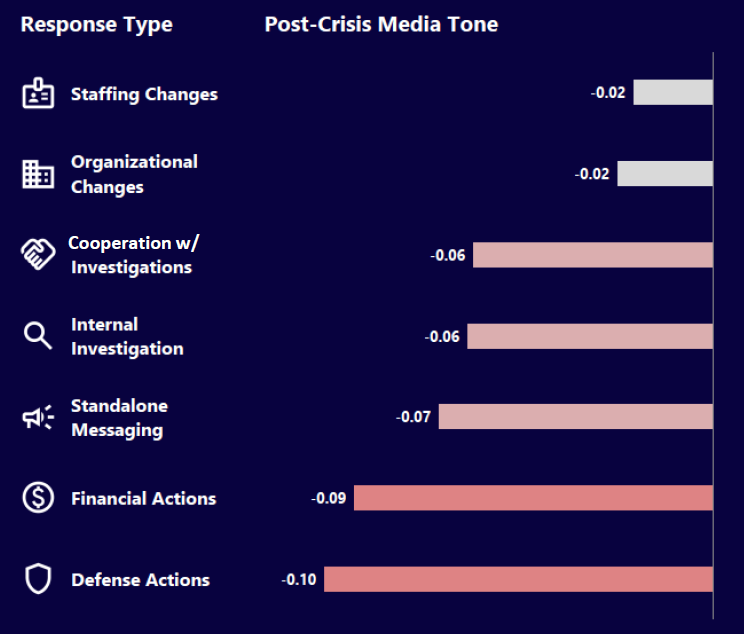
Conclusion
A consumer impact PR crisis is a defining moment for your brand. With the right strategy—immediate action, transparent communication, empathetic messaging, and genuine accountability—you can navigate the storm and emerge stronger. But the wrong approach risks alienating your customers for the long haul.
By leveraging real-time media intelligence and understanding the nuances of consumer-driven narratives, your communications team can craft responses that not only mitigate damage but also rebuild trust for the future.
Learn more about how PublicRelay’s Benchmark insights can guide your crisis response. Connect with us to see how data-driven strategies can enhance your media strategy.
You’ve built the Boolean string. You’ve tweaked the keywords. You’ve added exclusions, wildcards, and proximity operators and you have a paragraph of “OR”s and “NOT”s. But your media monitoring feed is still full of irrelevant mentions, missed context, or worse: you’re not capturing the stories that matter most, making effective media monitoring feel out of reach.
For Communications leaders, Boolean logic is often the foundation of media monitoring software. But in a world of overloaded news cycles, homonyms, acronyms, and increasingly nuanced brand narratives, Boolean-only media monitoring tools fall short, especially for those tasked with protecting and promoting complex brands.
The Limits of Boolean: When Logic Meets Reality
Boolean logic assumes that words alone are enough to define your brand coverage. But the reality of language and by extension, media, is far messier.
Take Amazon. Are we talking about the company? The rainforest? A person referring to a delivery from “an Amazon seller”? A Boolean string can try to rule these out, but it’s a never-ending game of whack-a-mole.
Or consider Apple. A recipe blog for that mentions “Delicious Apple Pie ” might sneak into your media coverage report, altering your idea of coverage count. Even for a company with an unmistakable name like Disney, not accounting for a nickname or shorthand like “The Mouse House” could mean a deep-dive profile of the company’s executive in Fast Company goes uncaptured because it wasn’t accounted for in the string.
And of course, a Boolean string can’t always distinguish between a brand name and an adjective. Brand names like Chewy pose challenges. Booleans may bring in pet food reviews of “Chewy Treats” that may or may not be relevant depending on the context.
These are everyday examples of why Boolean-only tools struggle to deliver the accurate media monitoring that modern communicators need.
Why It Matters: Measurement Starts with Monitoring
You can’t measure what you can’t reliably monitor.
When irrelevant mentions slip into your reporting—or critical stories are missed—it not only skews volume, it could send you in the entirely wrong direction, distorting sentiment, misrepresenting key message pull-through, and undermining your ability to show impact. You end up with incomplete dashboards, flawed benchmarks, and possibly even lost credibility with leadership.
Put simply: bad media monitoring leads to bad media measurement.
AI-Powered Human Intelligence
A human-supported AI approach saves you the time and resources your team would have to spend cleaning up after imperfect Boolean-only tools, applying human judgment to quickly and accurately filter media coverage, identifying the most relevant stories and surfacing the insights behind them.
This means you can:
- Confidently capture every relevant mention—even the ones Boolean logic would miss
- Eliminate false positives that pollute your reporting
- Identify and measure message pull-through with precision
- Understand tone and context that automation often overlooks
- Feed accurate data into your dashboards, attribution models, and strategic decisions
With a human + AI model, you don’t have to choose between scale and accuracy. You get both.
Want to Get Beyond Boolean Strings?
If you’re tired of building Boolean strings that never quite get it right or are frustrated by media reports that don’t reflect your reality, then it’s time for a better solution.
PublicRelay can help you monitor with confidence, measure with precision, and connect communications to business outcomes. Contact us.
The tariffs media cycle is at an all-time high, with coverage increasing 39% in the first quarter of 2025 alone compared to the entirety of 2024. This surge presents both risks and opportunities for companies across industries. While some brands face reputational challenges, others are leveraging the moment to showcase economic expertise and commitment to domestic investments.
Understanding how different sectors are being covered in the media can help communications leaders craft more effective messaging strategies. This blog will breakdown the following charts and explore how key industries are navigating the tariffs conversation:
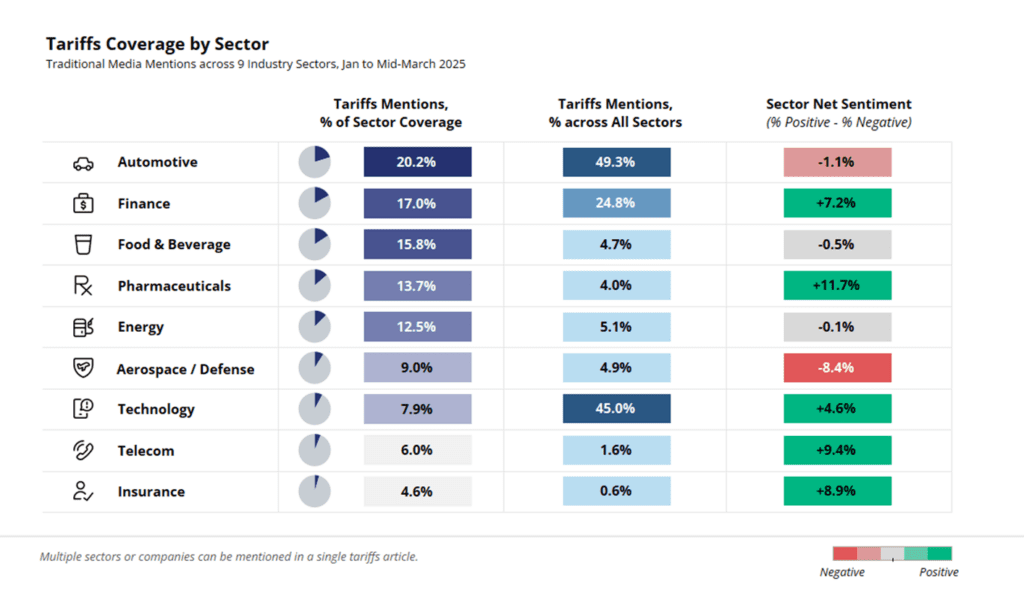
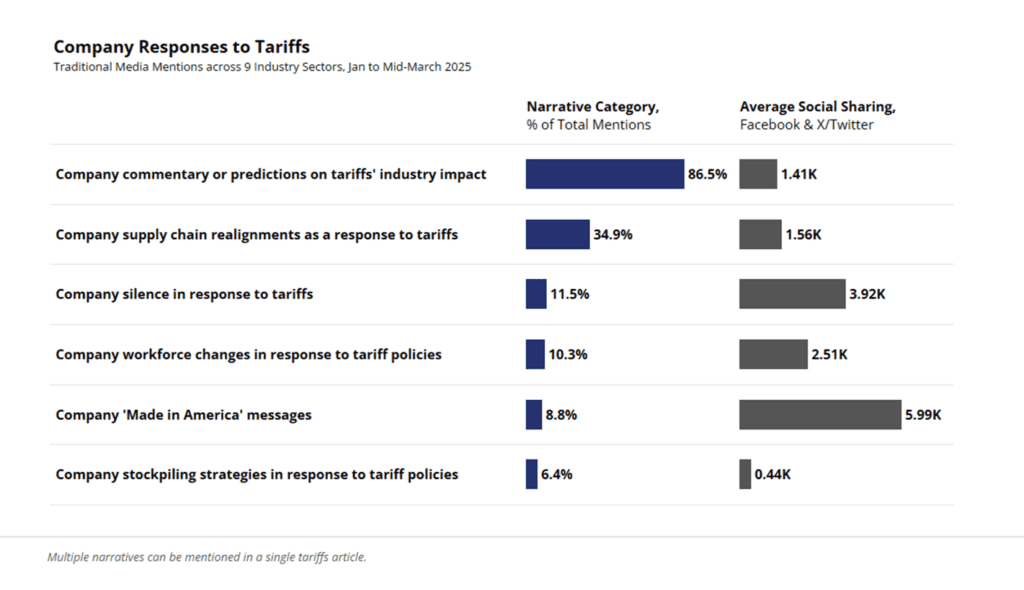
Finance & Insurance: Seizing Thought Leadership Opportunities
Finance and insurance firms have found a silver lining in the tariff discussions, benefiting from media interest in their market insights. Coverage has been positive for firms providing economic forecasts, investment strategies, and financial products designed to hedge against trade volatility. This sector’s proactive approach in addressing tariff implications underscores the power of positioning expertise as a media asset.
Tech & Pharma: The ‘Made in America’ Advantage
Technology and pharmaceutical companies are tapping into the growing interest in domestic manufacturing. The media has responded favorably to companies highlighting investments in U.S. production, with Big Tech firms receiving positive attention for securing tariff exemptions on key components like semiconductors. However, companies must balance these narratives carefully. Overstating ‘Made in America’ claims without tangible action could invite scrutiny from skeptical audiences.
Auto & Aerospace: Facing Supply Chain & Cost Pressures
For auto and aerospace companies, tariffs have primarily driven negative coverage centered on rising manufacturing costs and potential operational delays. These industries rely heavily on global supply chains, making them vulnerable to cost fluctuations. The media is closely watching how these companies navigate higher expenses, with a shift in focus likely if price hikes begin impacting consumers directly. Companies in these sectors may benefit from transparency in their supply chain adaptation strategies, positioning themselves as resilient leaders amid economic uncertainty.
Agriculture & Energy: Bracing for Consumer Price Scrutiny
Tariffs on agricultural goods and energy imports, particularly from Canada, have heightened concerns over consumer price increases. While media coverage currently focuses on investor sentiment and company performance, this may shift as higher costs trickle down to consumers. Communications teams in these industries should be prepared for intensified scrutiny and develop messaging that addresses both market challenges and proactive company responses.
Reputational Risks & Internal Communications Challenges
Beyond external media coverage, tariffs are also creating internal communications challenges. Employees at global companies are increasingly worried about workforce reductions due to trade policy changes. Though labor-related narratives are not yet dominant in media coverage, when they do arise, they spark significant social media reactions. Transparent internal communications can help mitigate employee concerns and prevent negative narratives from escalating externally.
Key Takeaways for Communications Leaders
- Resilience is Key: Supply chain-dependent sectors must communicate operational stability to mitigate reputational risk. Be transparent around solutions to consumer price fears.
- Seize the Moment: Companies less affected by tariffs can stand out by showcasing expertise navigating through trade volatility or amplifying their commitment to US investments.
- The Narrative will Shift: If tariffs have staying power, expect the media to shift to scrutiny of company resilience plans or speculations of consumer price gouging. Positive sentiment will be earned through messaging that aligns with stakeholder concerns.
With tariff discussions continuing to dominate headlines, strategic and sector-specific messaging will be critical in shaping how companies are perceived. Communications leaders who stay ahead of the evolving media landscape can turn challenges into opportunities, strengthening their brands even in a volatile trade environment.
To learn more about where we source our data and even request a full report walkthrough, contact us.
The High Stakes of Data Breach Crises
Few corporate crises have as lasting an impact on stakeholder trust as a data breach. According to PublicRelay’s benchmark data, the reputational impact of a data breach is 9x greater than other governance crises, which is a staggering difference that highlights how sensitive consumers, investors, and regulators are to cybersecurity failures.
And it’s not just a short-term hit. The media fallout from a data breach lingers for over half a year, with companies struggling to regain control of the narrative. Unlike other crises that may fade from public attention, lawsuits, regulatory scrutiny, and newly uncovered details often extend the media cycle, making it difficult to move forward. Effective crisis communication for data breaches is essential to mitigating reputational damage and maintaining customer confidence.
Because of your industry or company size, you may think there is limited risk for a breach, but according to Verizon’s 2025 Data Breach Investigations Report, “threat actors appear to care less about an organization’s size, industry vertical or geographical location than one might think. Today’s cybercriminal is a bit of a pragmatist and largely subscribes to the ‘I’ll be happy to steal whatever you have on hand’ view.” This means no organization is safe, and it’s likely better to be safe than sorry when it comes to preparing response plans.
What to Expect in the Aftermath of a Data Breach
Companies experiencing a data breach should prepare for a long and difficult reputational recovery. The media landscape following a breach remains overwhelmingly negative, with all cases analyzed in our benchmark showing sustained negative media tone scores post-crisis. This means that even well-handled responses tend to face an uphill battle in reshaping public perception.
Beyond negative press coverage, organizations must also anticipate significant legal and regulatory challenges. Data breaches frequently trigger lawsuits, regulatory investigations, and compliance reviews, all of which can stretch on for months or even years. Each new legal development risks reigniting media attention, keeping the crisis alive long after the initial incident.
Finally, a data breach directly impacts the trust of customers, employees, and investors. Stakeholders who once relied on a company’s security measures may now question its ability to protect sensitive information. Without a proactive effort to rebuild credibility, businesses risk long-term reputational damage that could impact customer retention, employee morale, and investor confidence.
Best Practices for Communicating During a Data Breach
The right communications strategy can make the difference between a temporary setback and long-term reputational damage. Here’s how to navigate the crisis effectively:
1. Act Fast. Be Transparent
When a data breach occurs, the worst mistake a company can make is delaying communication. Stakeholders expect to hear directly from the company involved, rather than through media reports or leaked information. Organizations must acknowledge the breach as soon as possible, even if full details are not yet available. This initial response should provide a clear overview of what is known, what steps are being taken, and what affected parties should do to protect themselves.
Transparency is key, but speculation should be avoided. Stick to confirmed facts and ensure that all statements are consistent across channels. This prevents confusion and reduces the likelihood of misinformation spreading. When companies are honest about what happened and what they’re doing to fix it, they demonstrate accountability and begin rebuilding trust.
After its data breach in 2013, which affected up to 110 million customers, Target faced criticism from stakeholders for knowing about the breach but not relaying the news until four days later. Though compared to other incidents, this is a relatively quick response, the fact that the news was broken by the cybersecurity blogger Brian Krebbs before any official announcement came from the retailer did not help perspective. Backlash was compounded by what was deemed inadequate communications with customers post-announcement. Customer services lines were flooded, “and a website banner informing customers of the breach was too small to see.” (Forbes).
2. Prepare for Extended Media Attention
Unlike other crises that fade quickly, data breaches tend to have a long media tail. The initial announcement is just the beginning. New details often emerge in the following weeks and months, reigniting coverage. Companies must be prepared for this prolonged cycle and should proactively provide updates rather than waiting for media inquiries.
A strong media strategy involves controlling the narrative by consistently reinforcing what the company is doing to enhance security. Regular updates on security improvements and internal investigations help shift the focus from the breach itself to the company’s commitment to preventing future incidents. Additionally, senior leadership should take an active role in public communication, demonstrating that cybersecurity is a top priority at the highest levels of the organization.
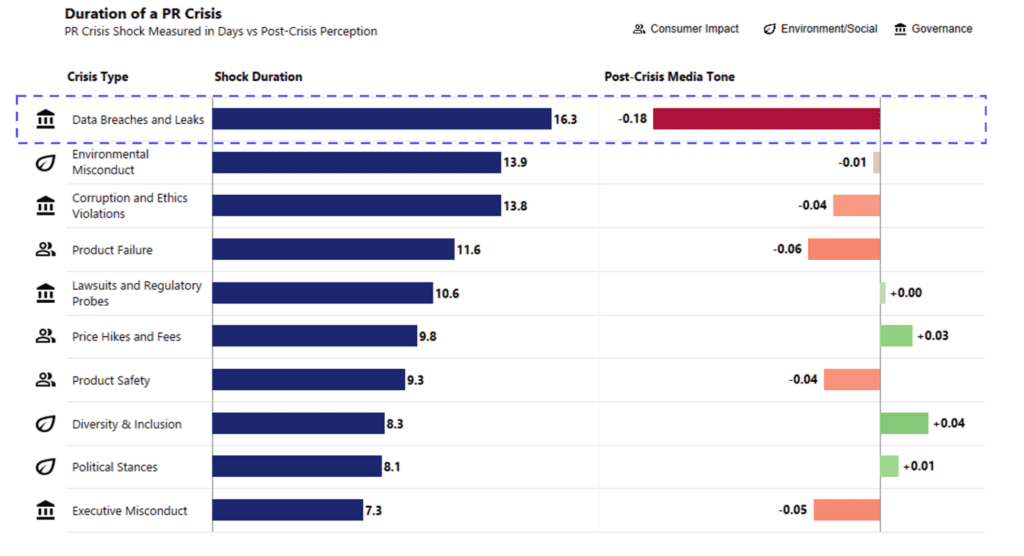
3. Use Cybersecurity Thought Leadership to Rebuild Trust
One of the most effective ways to recover from a data breach is to position the company as a leader in cybersecurity. Organizations that took this approach in past crises saw the strongest reputational recovery in our benchmark analysis. This means going beyond simply fixing the problem. Companies must actively engage in cybersecurity conversations, advocate for stronger protections, and showcase their commitment to data security.
Announcing an internal investigation is a critical first step. When companies publicly commit to identifying the root cause of the breach and implementing corrective measures, it reassures stakeholders that they are taking the issue seriously. However, it’s just as important to publicize new policies and security enhancements that demonstrate long-term improvements. Whether through blog posts, executive interviews, or industry panel discussions, organizations should make cybersecurity a central part of their messaging.
Finally, engaging in thought leadership by participating in cybersecurity forums, collaborating with experts, and contributing to discussions on data protection can help reposition a company as a proactive player in the security space. This shifts the narrative from one of crisis response to one of innovation and leadership.

4. Strengthen Your Cybersecurity Reputation Before a Crisis Hits
The best way to manage a data breach crisis is to build a strong cybersecurity reputation before one occurs. Companies that had existing credibility in this space experienced less severe reputational damage and faster recovery in our benchmark data.
Proactively communicating security efforts is essential. Organizations should regularly highlight their commitment to data protection through corporate communications, media engagements, and industry partnerships. This establishes a foundation of trust that can serve as a buffer in the event of a breach.
Additionally, building relationships with journalists and media outlets covering cybersecurity ensures that a company is seen as a credible source. This can be particularly valuable during a crisis, as having existing media connections can help ensure accurate reporting and prevent the spread of misinformation.
Your Response Matters
A data breach doesn’t have to define your company’s reputation, but your response will. The organizations that recover strongest are those that act swiftly, take accountability, and use the crisis as a catalyst to reaffirm their commitment to cybersecurity.
Last week, The Conference Board hosted Corporate Communications: Driving the Business Forward, bringing together top industry leaders to discuss the evolving role of communications in today’s business landscape. Below are some of the most compelling insights that emerged from the event.
The Business-First CCO: What CEOs Expect from Communications
The event’s opening session set the tone with a clear message: “CEOs are looking for CCOs who are business partners first, communications experts second.”
Denise Dahlhoff of The Conference Board bolstered this with data, and the theme was echoed by Thrivent’s CCO Greg McCullough and CEO Terry Rasmussen. Today’s most valued communicators:
- Possess strong business acumen
- Align messaging with corporate goals
- Prioritize outcomes over outputs
- Deliver and measure business impact
Throughout the conference, speakers reinforced this shift from traditional PR roles to strategic advisory positions:
- Jessica Kleiman (Lennar): Communications plays a critical role in talent acquisition, particularly for companies facing large-scale hiring needs.
- Golin: Their analysis found that CEOs with high media visibility in transformation and growth narratives boost corporate reputation, providing a key opportunity for CCOs.
- Katie Hill (NFL): The NFL is broadening its media reach, tracking not just sports media but also diverse outlets and influencers to engage new audiences.
In sum, Communications isn’t just about storytelling; it’s about driving measurable business success.
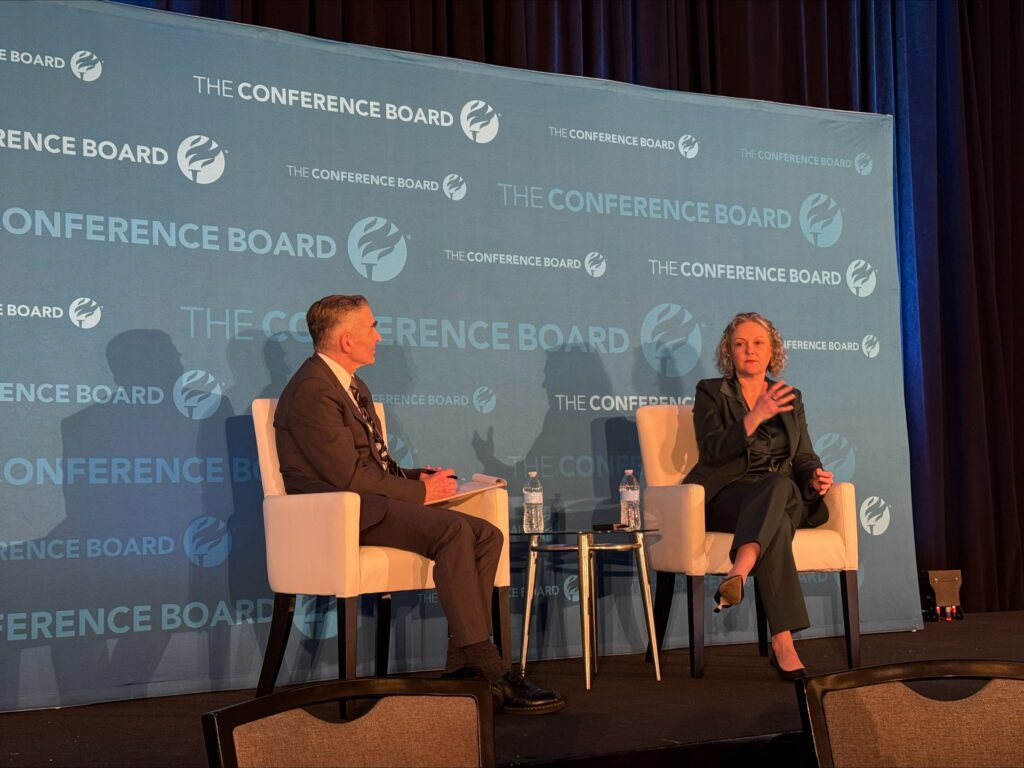
Reputation as a Business Asset
In a standout session, Allyson Park (Walmart) and Beatriz Perez (Coca-Cola) broke down why reputation should be treated as a business asset:
- 25% of a company’s market capitalization is tied to reputation.
- Reputation is shaped not just by messaging but by corporate actions. What you say yes and no to matters.
- When a new CEO arrives, redefining corporate purpose is a key moment for communicators to add value.
One major shift: Internal audiences—employees and customers—are now the priority over media relationships. Companies are focusing on building credibility internally, knowing that reputation starts from within.
AI’s Growing Role in Communications
Of course, AI was a hot topic throughout the event. Speakers shared real-world AI applications, from generating podcasts and short videos in real-time to monitoring outdated messaging, highlighting its potential but also its limitations. Points included:
- Use AI for efficiencies – fact-checking, summarizing news, and automating repetitive tasks.
- Lean on SMEs (subject matter experts) for nuance, judgment, and context.
- AI accelerates workflows, but it can’t replace human intuition, especially in areas like crisis comms and reputation management.
In sum, general agreement was that, while it can do incredible things on its own, AI should enhance human expertise, not replace it.
Navigating Corporate Engagement in Cultural & Political Issues
Panelists addressed the increasingly complex role of corporations in social issues. Key insights included:
- Companies are rethinking their approach to ESG & DEI messaging. They’re not pulling back entirely, but focusing on alignment between mission and business.
- Paul Dyer (/prompt) & Claudine Patel (Opella) shared that being culturally relevant is now a business imperative. They stated that the best approach was to follow societal trends, not marketing fads.
- Anna Frable (Novo Nordisk): Novo Nordisk’s efforts to elevate the conversation around obesity align with its business goals, making advocacy feel natural rather than forced.
Takeaway: Corporate activism isn’t disappearing, but companies are being more intentional about when, where, and how they engage.
The Communications-Marketing Partnership is Stronger Than Ever
Several sessions explored the increasing convergence of Communications and Marketing.
- Rob Jekielek (The Harris Poll): A unified PESO (Paid-Earned-Shared-Owned) approach is more effective than focusing on SEO.
- Data-driven storytelling is becoming the norm, requiring closer collaboration between comms and marketing teams.
What’s this mean for Communications leaders? You should be embracing cross-functional collaboration to maximize impact.
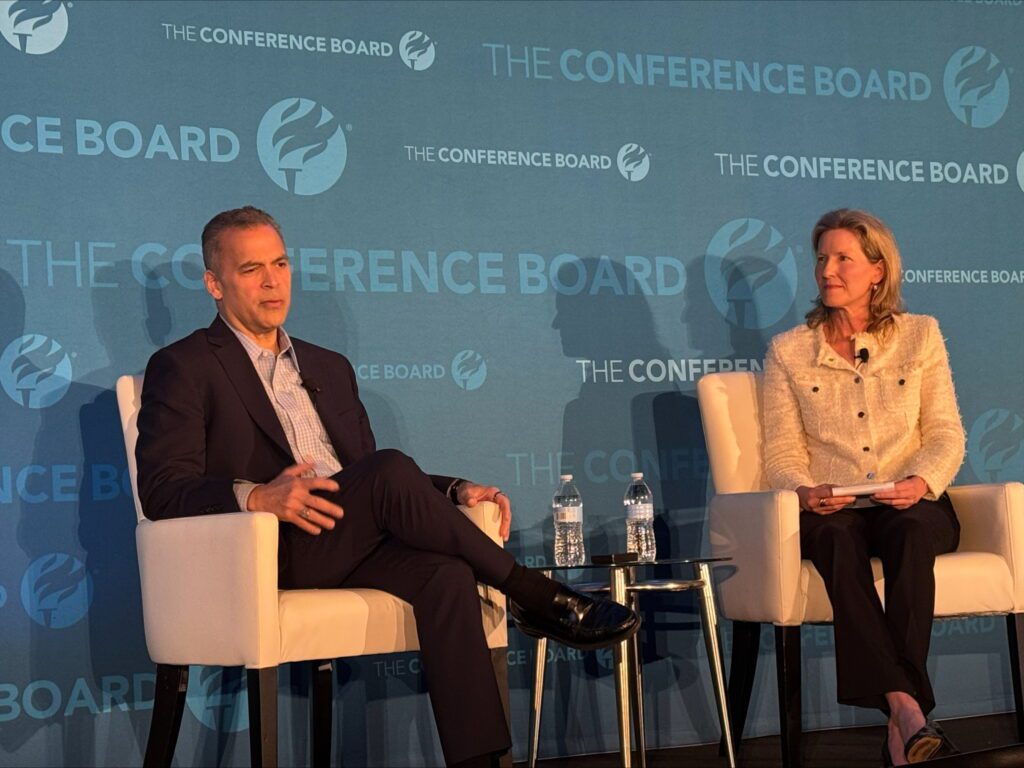
Final Thoughts
The Conference Board’s event highlighted a fundamental shift in the communications function: CCOs are no longer just storytellers. They are business strategists.
Communications teams that can demonstrate business impact, align with corporate goals, and leverage AI effectively will be best positioned for success. If you’re a communications leader looking to drive real business impact, these takeaways are just the beginning.
Let’s continue the conversation.
This post was written by Jim Key, VP of Enterprise Solutions at PublicRelay and attendee of TCB’s Corporate Communications event.
For quick-service restaurants (QSRs), the battle for consumer attention has never been more competitive or more price-driven. The past two years have ushered in a new normal in fast food, where value messaging dominates the media narrative and continues to shape brand strategy as we progress into 2025.
PublicRelay’s analysis of media coverage from 10+ QSRs shows a 500%+ increase in QSR messaging focused on value since early 2023. The trend isn’t just a response to inflation; it’s a fundamental shift in how brands communicate their offerings, defend their market share, and shape consumer expectations.
The Data Behind the Value War
QSRs are locked in an escalating cycle of promotional battles, as seen in recent media trends:
- May 2024 Surge: McDonald’s $5 Meal Deal launch ignited a sustained three-month media spike, forcing competitors like Burger King and Wendy’s to introduce rival promotions.
- Seasonal Fluctuations: Holiday campaigns momentarily pushed deal messaging aside in late 2023, while seasonal events (e.g., Lent specials) caused a brief dip in March 2024.

With each major promotion, competitive ripple effects extend media coverage beyond the initial campaign, proving that in today’s QSR landscape, value is a conversation that brands must continually engage in.
Why Value-Driven QSR Messaging is Non-Negotiable
Beyond media hype, economic pressures are making affordability a top priority for both consumers and brands:
- Inflation & Price Sensitivity: Fast food prices have surged 60% since 2014, far outpacing general inflation. Customers are more price-conscious than ever.
- Margin Squeeze: Labor costs have risen 22% since 2019, making cost-effective promotions essential to maintaining profitability.
- The Grocery Threat: Supermarkets now hold a 310-basis-point price advantage over QSRs, meaning fast food must prove its value beyond just price points.
In this environment, QSR messaging that reinforces value-driven storytelling is essential—not just for sales, but for sustaining brand relevance.
What This Means for Communications Leaders
For PR and communications teams, value messaging is a strategic necessity. Here’s what QSR communicators need to keep in mind:
- Short-Term Wins vs. Long-Term Strategy: Promotions create temporary media spikes, but brands must balance them with broader positioning that reinforces long-term brand equity.
- Echo Effects Drive Media Longevity: Competitive responses extend deal-driven media cycles. Smart brands capitalize on this momentum by keeping value narratives fresh.
- Digital Loyalty Is the New Value Play: App-exclusive deals are becoming a critical tool for reinforcing value perception while strengthening customer retention.
The Future of QSR Messaging
Expect value-driven narratives to peak in summer months and taper off during holiday seasons as brands shift focus to festive campaigns. Ensure value messaging remains compelling and sustainable beyond short-term promotions. For communicators, this is a test of agility. How will brands balance short-term promotional buzz with a long-term value platform that keeps customers engaged?
Connect with us to learn how PublicRelay can help your brand adapt to this value-first landscape.
Media Sentiment
For many communications professionals, media sentiment has become a divisive metric. On one side, some teams have abandoned it altogether, believing it’s too flawed, too time-consuming to clean up, and ultimately not worth the effort. Others continue to use sentiment analysis but acknowledge its imperfections, taking a “good enough” approach and focusing on the broad strokes rather than the details.
But what if sentiment analysis wasn’t just good enough? What if you could trust it? What if it was accurate and precise? What would that change for your strategy and for your ability to drive real business impact?
Sentiment Analysis: More Than Just Positive or Negative
One of the biggest challenges with sentiment analysis is its oversimplification. Most articles, social posts, and media mentions are rarely just “positive” or “negative.” They are layered, nuanced, and often depend on context—a factor that traditional sentiment analysis tools struggle to grasp.
Take the healthcare industry as an example. If an article contains the word “cancer,” many automated tools will automatically tag it as negative. But what if that article is discussing groundbreaking advancements in cancer treatment? The same applies across industries: what is perceived as negative in one context might be positive in another, depending on the publication, audience, and overall framing of the story.
Even within a single topic, sentiment can shift based on the type of publication. A trade publication covering financial regulation may take a different tone than a consumer-facing news outlet reporting on the same policy. Without an accurate way to account for these nuances, sentiment data can be misleading at best, and actively harmful to strategic decision-making at worst.
The Power of Sentiment When You Get It Right
When done correctly, sentiment analysis goes beyond categorization and becomes an actionable intelligence tool. It allows communicators to:
- Understand Stakeholder Perceptions: Different stakeholders (investors, customers, policymakers) perceive media narratives differently. Accurate sentiment analysis ensures that companies understand these differences and can tailor messaging accordingly.
- Capitalize on Trends in Real Time: Instead of reacting blindly to news cycles, communicators can identify opportunities to engage when sentiment is trending favorably, or mitigate risks before they escalate.
- Inform Business Strategy with Data-Backed Insights: Communications should be treated with the same rigor as other business functions. Precise sentiment data allows PR teams to demonstrate value to executives and make strategic decisions based on hard data.
Real-World Success Stories: How Trusted Sentiment Drives Results
1. A Publicly Traded Utility Company: Building Stronger Media Relationships
For a publicly traded electric utility company, positive brand perception is crucial—not just for customers but for investors and regulators as well. With coverage appearing in national, trade, and local outlets, the company needed a way to ensure their brand messaging was resonating across all audiences.
PublicRelay helped the team segment sentiment across publications and unveiled a key insight: most local coverage was favorable, but that wasn’t the case for certain national publications. This insight allowed the company to:
- Leverage historical sentiment data to identify which journalists and publications consistently covered them favorably.
- Build relationships with those reporters to ensure key messaging reached the right audiences.
- Use real-time sentiment tracking to course-correct messaging strategies and seize opportunities in the media landscape.
By integrating sentiment into their daily strategy meetings, the company transformed their approach to media engagement, strengthening their brand while ensuring alignment between local and national messaging.
2. A Leading Financial Services Firm: Optimizing Event Strategy
For one financial services company, sentiment analysis played a crucial role in event planning. Each year, the firm attended a major industry conference where they announced new products and initiatives. PublicRelay’s sentiment data revealed another key insight: the most positive media coverage from past conferences was directly tied to product launches.
Armed with this knowledge, the comms team:
- Recommended that leadership align major product announcements with the event to maximize positive sentiment.
- Used past sentiment data to set measurable goals and secure executive buy-in for their media strategy.
- Identified key journalists and outlets that had previously covered them positively, ensuring their announcements reached the right ears.
By trusting accurate, human-verified sentiment analysis, the firm was able to refine its strategy, secure stronger media coverage, and demonstrate ROI to leadership.
Key Takeaway: Sentiment Is a Powerful Tool (If You Can Trust It)
It’s understandable why some communicators have given up on sentiment analysis. Done poorly, it’s noisy, misleading, and more trouble than it’s worth. But when done right—with context-aware analysis and human expertise—it becomes an indispensable asset.
For companies navigating a complex media landscape, sentiment isn’t just about knowing whether coverage is positive or negative. It’s about knowing how to act on that information. It’s about identifying opportunities, mitigating risks, and proving the value of communications at the highest levels of the business.
So instead of asking, “Does sentiment still matter?” the better question is: What could you do if you had sentiment data you could trust?
This blog was written by Medha Chandorkar, VP of Product Management at PublicRelay.